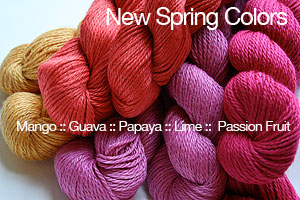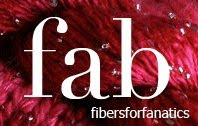It's a beautiful saturday up here in the Hudson Valley - and we are gearing up for the holidays - that's right, the HOLIDAYS!
We can already feel the onset of what makes up a wonderful part of our business - people shopping and buying yarn online for themselves, to knit projects for the holiday, or for knitting gifts for their friends, relatives and employees.
We've had some amazing gift purchases over the years - I remember one which was totally amazing - the CEO of a start-up shopping site in NYC bought all of his employees online yarn gift certificates! 150 of them! That was amazing. Then there was the celebrity knitter who bought everyone in her life gift baskets - 25 of them. That was amazing to put together and ship!
Some have difficulty shopping for yarn online. One of the reasons we started this fabulous yarn.com was that we WANTED to buy yarn online. I, in particular, didn't want to go driving from store to store, finding stores that had some stock, didnt have other stock. I wanted to be able to search for EXACTLY the type of yarn I wanted, and just BUY IT. I wanted it to show up at my door, not have to drag bags home.
Don't be shy - check out our knitting gift pages and see if you can't find something perfect for the knitter in your life. Something to make their jaw drop - we know you will!
Saturday, August 24, 2013
Tuesday, June 19, 2012
Cashmere yarn for knitting
http://www.fabulousyarn.com/cashmere.shtml
Want to know more about Cashmere Yarn?
It is no small wonder
that cashmere and the yarn spun from it is one of the most precious and prized commodities in the
world. It comes from the downy underfleece of the cashmere goat which
makes its home in the highest and most inhospitable plateaux of Mongolia
and Xinjiang. Each year one goat produces a meagre 4.5 oz of under
fleece, which is painstakingly combed out every spring by nomadic
herdsmen. It takes the hair of one goat to make a scarf, two or three
for a jumper depending on the weight; 60% of each fleece is discarded.
However, it is what happens next that makes the difference between
run-of-the-mill and quality cashmere.
Ever since Victorian
England "discovered" the loft, warmth and feel of fabric made from
Cashmere, it has been in demand for those in high society. Just pick up a
novel or a fashion magazine, especially in the Fall, and you will see
references to cashmere sweaters, socks, suits and shawls... all costing a
lot of money. Historically, demand for these items has remained steady
through feast and famine, war and peace. This is because of the
wonderful feel or handle of the fiber combined with low bulk and high
loft. These factors combine to make the warmest, softest and most
comfortable garment money could buy.
Cashmere producing areas
remained in the Himalayan region throughout the first part of the 19th
century, extending east to China and west to Iran. But because of
political and geographical barriers, western clothiers never saw the
animals that produced the fiber; they bought cashmere in bulk, primarily
from India, China, Iran and Afghanistan.
Both
Australia and the American Southwest were settled by a tremendous
influx of immigrants from Europe. These peoples brought with them as
much as they could from the "old country" and this included the domestic
goat, known for its durability during long sea voyages, and as a
provider of milk and meat. Over the years in Australia, farms failed and
many goats escaped, resulting in flocks of wild, or feral, goats in the
vast interior "Outback". In America, especially in the Texas "outback",
huge tracts of arid lands were dedicated to running what is called a
"Spanish" goats because nothing else would thrive. In neither
environment were these goats tame. They ran wild most of the year and
were rounded up annually to harvest the young animals for the meat
market. It was the Australians who first noticed that natural selection
had produced a hardy, robust and wily animal, some of which had a
luxurious, downy undercoat as protection from the weather. In the late
1970's, the Aussies began selecting those fiber bearing animals and
selectively breeding them in an effort to establish a new industry.
Some Australian goats
were exported to the United States in the mid 1980's. Emphasis was
placed on fiber production, diameter and style, the natural "crimp"
along the length of an individual fiber. As the search for suitable
mates for these few imported animals progressed down to Texas, it was
discovered that our own Spanish goats had similar fiber already! These
animals were removed from their wild environment and bred to the Aussie
imports with visions of bales of fine cashmere dancing in our heads.
Very quickly we learned that cashmere is an elusive target. The very
does who exhibited fine fiber in the wild, suddenly turned into well fed
matrons that produced a similar fiber that was not cashmere and could genuinly, when spun be called cashmere yarn. This fiber
was at the time, called cashgora, although it is not truly a cross
between cashmere and mohair, produced by the Angora goat. Later research
proved that fiber diameter in goats is controlled both by genetics
(genotype) and environment (phenotype) and that goats raised under less
than optimum conditionscan exhibit finer fiber than they would
otherwise, as is the case in China, where even the people are underfed.
Goats exposed to a greater nutritional level as is necessitated when
removing them from the arid southwest and taking them to Colorado, New
Hampshire or Washington State, resulted in the production of this
coarser, straighter, but still luxurious fiber, now called commercial
cashmere.
True cashgora has a
third fiber type called kemp, and is very much avoided by both the
mohair industry and the cashmere industry. Especially in young animals,
it is very difficult to differential between cashmere and cashgora.
Unfortunately, this lead to the introduction of many "top quality
cashmere goats" that were not, resulting in many disenfranchised and
disappointed breeders.
The good news is that we
have realized the role that environment can play in fiber quality and
have redoubled our efforts to identify goats that are genetically
capable of producing cashmere. While we have not yet established a true
breed of cashmere goat, one that will pass along its desired genetic
package the majority of the time, we have made great progress and are
now producing American grown cashmere.
Organic Yarn from Upstate NY
Awesome Farm Handspun Dorset Wool. Dorset/Polypay
handspun wool - This 2-ply handspun organic wool yarn goes thick and thin, is very textural, and
very different from most of the spun wools I've seen - they are usally
very even - this is different. Look closely at the wound balll on the
left and you'll see puffs on one section, and then down to a very
tightly plied yarn in another. It's fantastic.The skeins are either 75
or 100 Yards, and it's first come first served. Please order enough for
your project - this is one of a kind yarn and when it's gone its' gone.
Wednesday, April 25, 2012
Yarn Dreams
Dreams & Happy Things...: Knitting Things: I wish there was a knitting fairy that would secretly bring me everything on my wish list! This set of needles... http://www.fabulousyarn...
Go to the site and enter Dream and WIn - you never know, you could win the YARN of your dreams!
Go to the site and enter Dream and WIn - you never know, you could win the YARN of your dreams!
Wednesday, August 4, 2010
Spud & Chloe Totes and Pencil Cases!
Amazing, took me almost a month to actually get around to posting these - but they are fabulous - the tote is a limited edition reversible number (the reverse fabric is sort of a pun on the chanel logo, or coach, but with S&C instead). Machine washable - the perfect size, and it has the matching pencil case which is awesome!
Check it out here:
Spud & Chloe Totes & Pencil Case
Check it out here:
Spud & Chloe Totes & Pencil Case
Friday, March 19, 2010
Blue Sky Alpacas Silk and alpaca Yarn
Blue Sky Alpacas Silk and alpaca Yarn
Blue Sky Alpacas Alpaca and Silk yarn - a beautiful 50/50 blend of alpaca and silk. A delightful, shimmery, lightweight yarn that shows the best of both fibers. The
soft, pure alpaca yarn, for lightness and warmth, the silk for sparkle,
sheen and depth of color and of course, done color palettes that Blue
Sky Alpacas is famous for - from natural, to jewel brights, to pastels
With Blue Sky Alpacas, it's pretty much guaranteed - you
The
soft, pure alpaca yarn, for lightness and warmth, the silk for sparkle,
sheen and depth of color and of course, done color palettes that Blue
Sky Alpacas is famous for - from natural, to jewel brights, to pastels
With Blue Sky Alpacas, it's pretty much guaranteed - you
Blue Sky Alpacas Alpaca and Silk yarn - a beautiful 50/50 blend of alpaca and silk. A delightful, shimmery, lightweight yarn that shows the best of both fibers.
 The
soft, pure alpaca yarn, for lightness and warmth, the silk for sparkle,
sheen and depth of color and of course, done color palettes that Blue
Sky Alpacas is famous for - from natural, to jewel brights, to pastels
With Blue Sky Alpacas, it's pretty much guaranteed - you
The
soft, pure alpaca yarn, for lightness and warmth, the silk for sparkle,
sheen and depth of color and of course, done color palettes that Blue
Sky Alpacas is famous for - from natural, to jewel brights, to pastels
With Blue Sky Alpacas, it's pretty much guaranteed - you Tuesday, July 14, 2009
Starting Now!
So many people have asked for a way to talk about the yarns they bought at fab, the experiences they've had. So heres the place to do it!
Why did we choose blogger? One, because ANYBODY can. And we like that. Two, because its' open and not 'controlled' by us. Three, because it's a google thing. And four, most importantly, its EASY!
This is also a way to ask questions and get fast answers - since we're not always at the store, this blog allows us to be online virtually ALL THE TIME - because it goes right to our phones. Have a question about inventory? Ask us. We'll get back to you fast. Need to know about a color? Go ahead, we'll get your post within minutes and be able to respond just as fast.
Please also keep in mind that we are also on twitter - fabulousyarn@twitter.com, and that will work, too!
Judy
Why did we choose blogger? One, because ANYBODY can. And we like that. Two, because its' open and not 'controlled' by us. Three, because it's a google thing. And four, most importantly, its EASY!
This is also a way to ask questions and get fast answers - since we're not always at the store, this blog allows us to be online virtually ALL THE TIME - because it goes right to our phones. Have a question about inventory? Ask us. We'll get back to you fast. Need to know about a color? Go ahead, we'll get your post within minutes and be able to respond just as fast.
Please also keep in mind that we are also on twitter - fabulousyarn@twitter.com, and that will work, too!
Judy
Subscribe to:
Posts (Atom)



